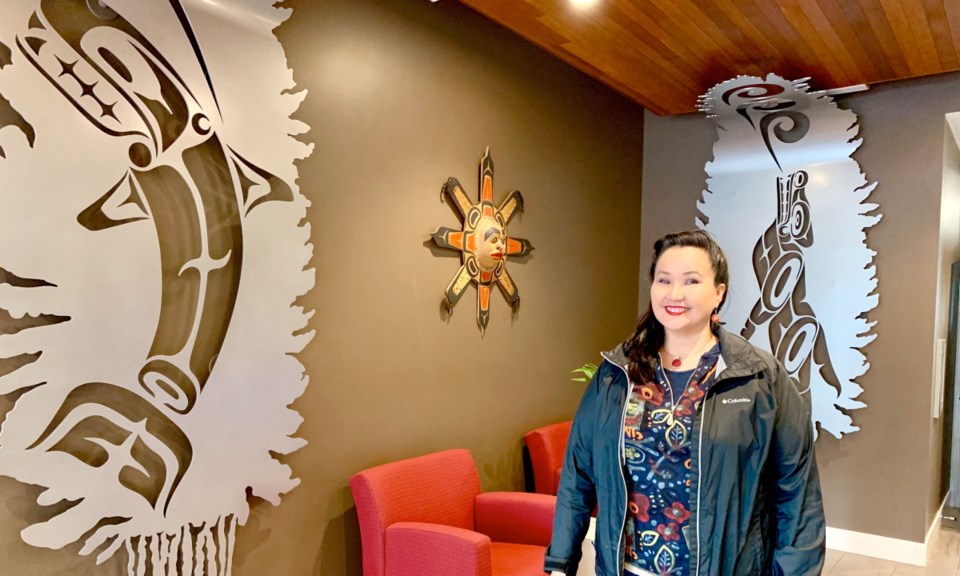The first time I saw the work of Indigenous artist and interior designer Connie Watts, I was mesmerized.
I was at the Songhees Wellness Centre, looking at a beautiful light fixture built in the shape of a canoe with northwest coast Indigenous designs in it. The light fixture was hanging from the ceiling in the boardroom. The lobby of the building displayed photos, etched glass on the doors and even a copper panel representing woven cedar above the reception desk.
The interior design and art elements in the building beautifully capture the richness of Indigenous culture, the pride of Indigenous heritage and impressive art elements displayed in a cohesive package. Even the carpet tiles were installed to reflect woven baskets.
What Watts does with design is a tangible reflection of what I wish everyone would think of when they think of Indigenous people, history and culture.
Watts’ work is the best of the best, top-notch and innovative. She works in a variety of media, and it’s apparent that she sees no limits to where she can take her art.
When I see Watts’ art, it halts me in my tracks. Her work is professional, inspiring, innovative and flawless. I believe she is paving the way for Indigenous youth to demonstrate how culture and traditions can be incorporated seamlessly into a professional occupation and be appreciated by people from all walks of life.
Every job Watts has taken has included some Indigenous elements, because her work is an extension and reflection of herself; she is proud and honoured to bring West Coast art into everything she does. Elements from her Nuu-chah-nulth, Gitxsan and Kwakwaka’wakw background are rooted in everything she does.
“I want people to know that we as Indigenous people are here, we’re alive, strong and proud,” said Watts. “I like to use emotional concepts and tell a story through Northwest Coast iconography.”
Watts acknowledges that there are a lot of stereotypes regarding Indigenous people and she wants to challenge these stereotypes and demonstrate the excellence that Indigenous people can offer.
“When people hear that I am an Indigenous artist, they always ask me what I carve,” said Watts.
When Watts was a child, her mother often told her she had a creative gift, even though at the time Watts didn’t see her gift. She never thought of herself as a creative person, “just someone who made stuff.”
As a teen, Watts was a straight-A student and knew she was going to post-secondary education, because that is the way her mother raised her. When it was time to choose her specialty, it was the process of elimination. Watts landed on interior design and headed to the University of Manitoba to attend the best interior-design program she could find.
“I didn’t really know what interior design was. I thought it was just decorating,” Watts said with a laugh. “I learned about systems, architecture, human nature and design.”
Shortly after graduating university, Watts was involved in a car crash that was the fault of another driver.
“I suffered a double skull fracture,” she said, explaining she had to relearn how to do most things. “I had a base level of reading and writing, but I don’t really remember much from that time.”
During her recovery, Watts went into the industrial-design program at Emily Carr University of Art and Design. She was having a tough time in school, and then changed her program to study fine arts.
“I didn’t understand the extent of my brain injury,” Watts said. “I chose fine arts to build my brain back up. There are no rules in fine arts; design has a whole list of parameters that need to be followed.”
It was switching to fine arts that morphed Watts’ experience in design to a real cultural expression that displays both purpose-driven features and artistic flare, both with a vibrant, unmistakable Indigenous pride.
Watts’ big break is a thunderbird sculpture suspended from the ceiling in the Vancouver Airport. Since then, Watts has provided interior design, including many Indigenous elements and art pieces designed by her, for office buildings, public art and private collectors. She teaches courses through Vancouver Island University and has worked on several books, including many Indigenous-language books.
In 20 years, I am certain there will be a new generation of Indigenous creative professionals building on the foundation laid by Watts, demonstrating how powerful and well-received Indigenous pride and professionalism can be.
Charla Huber is the director of communications and Indigenous relations for M’akola Group of Societies.



